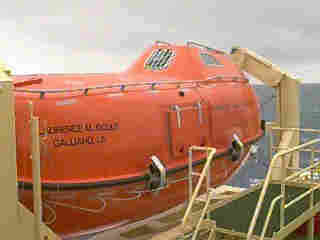26 January, 1998
Gould-en Greetings!
Land-Ho! We finally made it to Palmer Station. Palmer Station is very
small compared to McMurdo Station, which is more like a complete city.
Palmer is located on an island right off of the peninsula.
As we approached the dock, there was an iceberg in front of the dock. The
captain went to the side of the berg using the iceberg as a fulcrum to
pivot around the berg. By doing this we swung around right next to the
dock. Most of the day has been spent unloading supplies to Palmer and
loading on Palmer's trash. They have not had a supply vessel since April!
I walked around the station and found elephant seals lying about.
Unfortunately, I couldn't get close enough to them to get a clear picture.
I will try for a penguin picture this evening, as I am supposed to ride out
to the nesting area called a rookery on a small island nearby. Otherwise I
was occupied today by helping weigh chemicals to make testing reagents.
Seeing all of the icebergs made me glad we had a safety check (drill) on
the rigid lifeboats. The are two of these lifeboats and each one can hold
44 people, more than the number of people who reside on the entire ship.
The lifeboats are heated and completely enclosed. It even has a cupola
(small enclosed rise on the top of the lifeboat that has a window for
viewing) so the one steering the lifeboat can do so from inside. There are
also 2 inflatable life boats, but they are not enclosed. If the captain
determines that there is a life-threatening problem with the ship, the
signal to get into our mustang survival suits and board the lifeboat is 7
short blasts followed by one long one.
We didn't have any problems, though the Gerlache Straits were filled with
outstanding icebergs of startling blue and white hues. Every once in
awhile we would pass an iceberg with Adelie penguins on it. One time, the
iceberg not only had penguins, but there was also a leopard seal patrolling
around the edges looking for a meal! I also spotted one humpback whale
about a mile away and three minke whales. Size and the shape of the dorsal
fin help in determining the species of whale being seen. There are many
skuas here. Cape petrels kept us company for the second half of the passage.
Warm regards,
Mrs. D

Contact the TEA in the field at
.
If you cannot connect through your browser, copy the
TEA's e-mail address in the "To:" line of
your favorite e-mail package.
|
